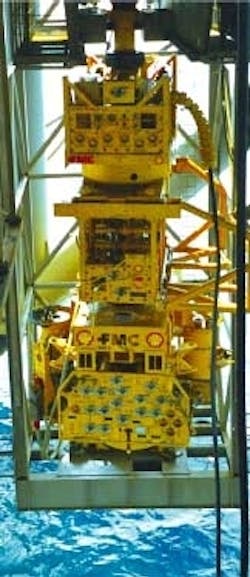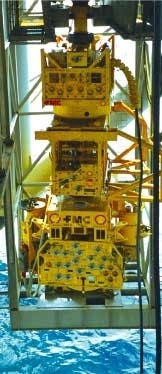Subsea/Surface Systems
FMC Q4000 intervention riser system.
In addition to a host of innovative systems, Caldive International's new semi-submersible Q-4000, which is a multi-functional intervention vessel, will make use of a new 15,000 psi. intervention riser system, rated to a water depth of 10,000 ft. The intervention riser system design is based on actual offshore operational experience, and it will be the first operational system, that can access high pressure subsea wells, in this water depth.
This system will be used for "thru tubing" intervention work, on both conventional and horizontal subsea trees, with the ability to carry out all aspects of wireline, coiled tubing, well clean up and subsea tree installation operations. It also can be used for the decommissioning and abandonment of deepwater subsea wells, as shown with the removal of the recent removal of seven subsea trees in 2,200' water depth, by the CDI Uncle John in 2000.
The intervention riser system, has a single 5.125" production bore, complete with the relevant BOP's and valves, to give full well control during all intervention operations, and, if annulus access is required, or there is a need to circulate, there is a 2" 10,000 psi. annulus hose that can be run with the riser, with the annulus side having its own relevant valves for well control. The mono-bore riser can also be run inside a drilling riser, if desired as a landing string.
This type of intervention system offers the advantages of a high working pressure, without the weight, or difficult handling that comes with a full drilling riser system, as we will not be drilling, we don't need this type of equipment. The riser comes in 45' joints, and is similar to drill pipe, except it has a thicker wall, and has premium connections, to handle hydrocarbons. The system has been designed to avoid the need for buoyancy modules, that will be picked up and made up as "doubles" to increase the running/pulling time of the system.
While the technical limit of an intervention riser system in the field today is around 7,500' water depth and 10,000 psi, this new system will be able to handle subsea equipment and trees being installed in deepwater today and in the future.
Canyon 3K meter ROV on Q4000
Canyon Offshore recently announced it rec-eived the ROV (remotely operated vehicle) contract for the Q4000 intervention vessel. Canyon has custom-designed a Venom 3K-150 ROV with a depth rating of 3,000 meters (10,000 ft water depth). The vehicle is currently being built by Hydrovision and will incorporate an extensive package of specialized tools and advanced features including a dual hydraulic system that separates the Curvetech Propulsion system from the tooling system. The 27-mm diameter tether allowing excursions of up to 1 km. The ROV will be integrated into the vessel this year with a special heavy-weather deployment system. This top-hat Tether Management System (TMS) has a patented swiveling fair lead and has auto tension roller guides.
Autonomous vehicle partnership
The Boeing Company, Fugro GeoServices, Inc. and Oceaneering International, Inc. have formed a partnership to provide advanced underwater survey services. The venture combines Oceaneering and Fugro's marine experience and knowledge of customer requirements with Boeing's unmanned vehicle and autonomous guidance technologies.
The suite of new underwater services will initially be targeted at the exploration market, as well as telecommunications. Sea trials are scheduled this year, and the services should be available by 2002. Boeing will be responsible for the autonomous vehicle portion of the system, while Fugro will provide the sensor payload and data analysis technologies. Oceaneering will be in charge of the support vessel, including the vehicle launch and recovery system.
The proposed underwater vehicle is intended to eventually replace towed survey systems presently used to collect sonar, bathymetric, and sub-seafloor profile data. It can be launched from a wide range of surface vessels and reach water depths of 10,000 ft while autonomously performing pre-programmed survey missions.
Global supports Serrano/Oregano tie-in
Global Divers and Contractors recently installed a 16-in diameter I tube at the Auger TLP for Shell E&P using wet welding technology. The steel tube was welded to one of Auger's four, 74-ft diameter columns, which will protect and support the control umbilical for Shell's Serrano and Oregano subsea developments. These developments are scheduled to be tied back to Auger some time in 2001. The Auger TLP is located in 2,860-ft water depth on Garden Banks block 426, in the Gulf of Mexico. Serrano is located in Garden Banks 516 and 472. It will be tied back six miles to Auger with first gas production scheduled for later this year. Oregano is located in Garden Banks 558 and 559. It will be tied back 8 miles, also to Auger, with first oil also expected later in 2001. Both of these subsea fields are located in 3,400-ft water depth. This project is the second in which Global has used wet welding technology to install an I-tube for Shell. In 1998 Global performed a similar installation on Auger to support Shell's Macaroni subsea tieback, which is located in Garden Banks 602 in 3,700 ft water depth.
Maureen re-float planned
This summer Aker plans to re-float Phillips' Maureen Alpha gravity-base platform in the North Sea. Although the platform was originally designed to be re-floated for use at another site, this will be the first time a platform of this size has been re-floated. Aker is working closely with operator Phillips on the detailed plan for this operation. The platform was originally installed in 1983 on a location about 260-km northeast of Aberdeen. Since then, the platform has handled about 223 million bbl of oil. In 1999 it was determined the field had reached the end of its economic life. To re-float Maureen, Phillips developed a method to disconnect the platform from the seabed and to bring the substructure, made up of three huge tanks, into a towing position. Gravel and magnetite will be inserted around the edge of the tanks to support them, while high-pressure water is injected under the tanks to free them from the seabed. At the same time the tanks will be de-ballasted. As the water is pumped out of the tanks, nitrogen will be injected in to them. This buoyancy should slowly lift the 110,000 ton platform from the seabed. It will require 18 meters clearance. If everything goes as planned, the tops of the three storage tanks, with a combined capacity to hold 650,000 ton of oil, will break the surface after resting in 95 meters of water for almost 20 years.

